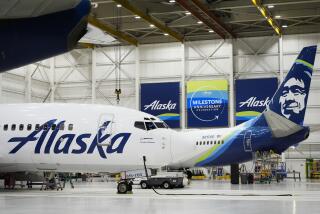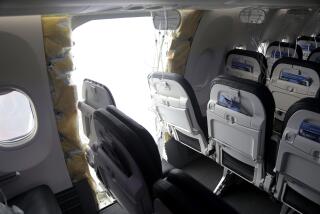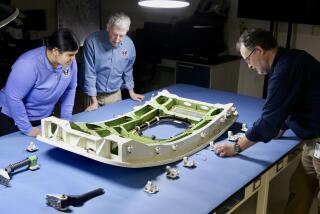German airline crash: ‘You can hear he is trying to smash the door down’
The mystery surrounding this week’s crash of a German airliner into the French Alps deepened Wednesday with a report suggesting the pilot may have been locked out of the cockpit before the crash.
UPDATE: French prosecutor says Germanwings copilot appeared to want to destroy the plane
The New York Times quoted a military official saying that evidence from the cockpit voice recorder for Germanwings Flight 9525 suggested that the pilot left the cockpit at some point and appeared unable to get back in - pounding on the door in the moments before the crash.
“You can hear he is trying to smash the door down,” the official told the Times.
Locked cockpit doors have been a familiar safety feature of most international airlines since the Sept. 11, 2001, hijackings, when the seizure of four airliners by terrorists pointed up the potential danger of allowing outsiders into the cockpit.
But what measures are in place to make sure the pilot can enter? And are copilots supposed to be left alone in the cockpit?
At a news conference Thursday, Lufthansa Chief Executive Carsten Spohr said the airline was not required to bring a flight attendant into the cockpit if a pilot leaves to go to the bathroom or get a drink.
“I don’t see any need to change our procedure” immediately, Spohr said at a televised news conference, adding that the airline would discuss procedures with security experts.
According to the Federal Aviation Administration, in the U.S., “when one of the pilots exits the cockpit for any reason, another qualified crew member must lock the door and remain on the flight deck until the pilot returns to his or her station.”
Glen Winn, an aviation instructor at USC and an expert in aviation security and anti-terrorism, said American air carriers typically have a flight attendant step into the cockpit with the copilot of the pilot steps out.
“You ask any pilot, they’ll tell you the same thing,” Winn said. “They don’t leave a person alone in the cockpit. They don’t do it. Nobody does that.”
The German Airbus A320 with 150 people on board was flying at 38,000 feet on its route from Barcelona, Spain, to Duesseldorf, Germany, on Tuesday when it began a roughly 10-minute descent into a rugged area of the French Alps at an altitude of about 6,800 feet.
According to the Times report, the pilot had already left the cockpit when the plane began its descent.
That raises the question of whether the other pilot was incapacitated or deliberately launched the descent, or whether some mechanical problem led to the altitude change.
New safety protocols mandated by Congress in the U.S. after the Sept. 11 attacks would almost certainly have been in place for aircraft operated by Germanwings on behalf of Lufthansa, which shares standardized safety procedures with American airline carriers, Winn said.
These protocols eliminate the use of keys for entering the cockpit - assuring that no errant passenger can wrestle a key away from a crew member. They also require cockpit doors to be strong enough to withstand gunfire and grenade explosions.
“I know in U.S., post 9/11, the cockpit door is the most secure door on the plane,” said Anthony Brickhouse, associate professor of safety at Embry-Riddle Aeronautical University.
American experts say the typical procedure is for a flight attendant to use a food cart to block access to the cockpit when the pilot opens the door to leave. A flight attendant is supposed to remain in the cockpit and open the door for the pilot upon his or her return.
“It’s a standard procedure” that Germanwings should have followed, Winn said. “That’s nothing secret. Everybody knows.”
If a member of the flight crew doesn’t open the locked cockpit door from the inside, according to a manual for the Airbus A320 available online, the door can also be unlocked by the cabin crew outside the cockpit by entering a two- to seven-digit code, pre-programmed by the airline, on a keypad.
Jim Hall, former chair of the National Transportation Safety Board, said at least one previous airline disaster followed the departure of the pilot from the cockpit - the 1999 crash of Egypt Air Flight 990, which U.S. investigators attributed to the flight’s first officer.
“The copilot waited until the pilot had left and gone to the restroom and then put the aircraft in the dive,” Hall said.
But the Germanwings aircraft did not appear to have entered a dive, Hall said. “It sounds more like a gradual descent.”
The Germanwings flight had issued no distress signal or other communication during its last minutes. Officials said the plane, which was built in 1991, had undergone a safety checkup this month. The pilot had more than 6,000 hours of flying experience on Airbus aircraft.
“You can use a little bit of logic here – the pilot that was in cockpit either didn’t want the other pilot to come in or wasn’t able to let him in,” said Barry Schiff, a former TWA captain of 34 years and an aviation safety consultant based in Camarillo. “Only those two possibilities exist, and it leads you down some interesting paths.”
But Thomas Anthony, director of USC’s Aviation Safety and Security program, cautioned against jumping to conclusions.
“It’s never one thing,” Anthony said. “Every aircraft mishap is composed of more than one causal factor. Usually it’s four or five things coming together. Our minds like to simplify and say it’s this [one thing, but] that identification of the single cause is usually just the last cause in a chain.”
Anthony then repeated: “It’s never one thing.”
Follow @MattDPearce for national news.
UPDATES: Latest developments on the crash
Traveling by plane: Trends show it is getting safer
More to Read
Start your day right
Sign up for Essential California for news, features and recommendations from the L.A. Times and beyond in your inbox six days a week.
You may occasionally receive promotional content from the Los Angeles Times.







